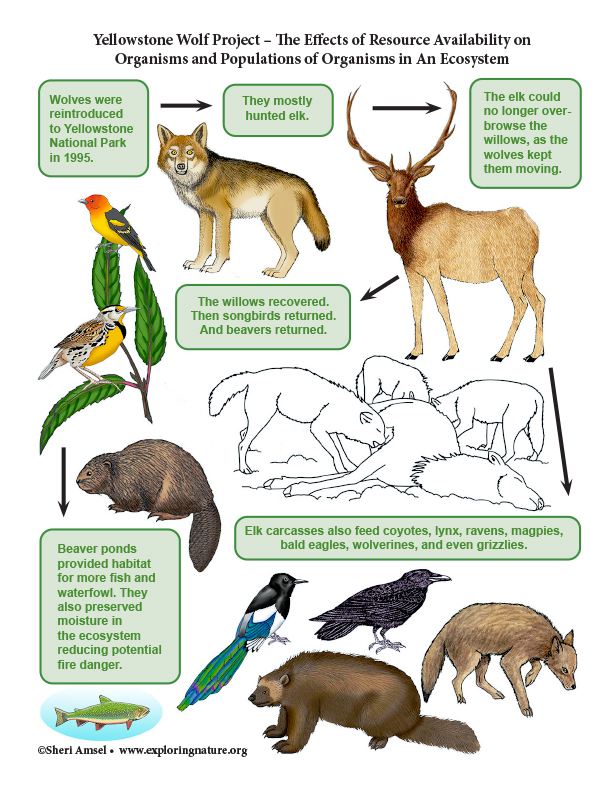

Wolves were driven almost to extinction in the western United States in the early 1900s by farmers and ranchers who wanted to protect their livestock from predation. This had an effect on other populations of animals and plants, but scientists didn’t completely understand how big of an effect until they reintroduced wolves to Yellowstone National Park in 1995.
The U.S. Fish and Game Service reintroduced 41 wolves from Canada over a two-year period (1995-97). The wolves preyed upon the herds of elk in Yellowstone mostly. The elk, in turn, fed on shrubberies - especially willows, that lined all the waterways. They fed on willows especially in winter, when grass and other planets were buried under the snow.
Before the wolves, the elk over-browsed the willows and aspens down to their woody stems. Once the wolves hunted Yellowstone, the elk had to keep moving to avoid the large predators. They could only lightly browse the willows and aspens before moving on to the next area. This allowed the willows and aspens to recover and flourish, providing habitat for songbirds and food for beaver. Previously, the beavers had almost disappeared from the Yellowstone ecosystem. Now there was an abundance of food for them in the ecosystem.
As the beaver multiplied, they built dams and formed new ponds. This created new habitat for fish and waterfowl. It also helped preserve the water from the spring runoff in the ecosystem, decreasing summer droughts. Scientists speculate that this preservation of moisture in the habitat created by the beavers may have prevented the devastating fires that ravaged Yellowstone in 1988.
Wolves killing elk and leaving their carcasses after feeding also goes on to feed a myriad of other animals in the Yellowstone ecosystem, including coyotes, lynx, ravens, magpies, bald eagles, wolverines, black bears, and even grizzlies.
The number of wolves in Yellowstone fluctuates every year due to disease, pup survival, prey availability, and other factors. Learn more about this by completing the Yellowstone Wolf Project - Population Study and Graphing Task.
When you research information you must cite the reference. Citing for websites is different from citing from books, magazines and periodicals. The style of citing shown here is from the MLA Style Citations (Modern Language Association).
When citing a WEBSITE the general format is as follows.
Author Last Name, First Name(s). "Title: Subtitle of Part of Web Page, if appropriate." Title: Subtitle: Section of Page if appropriate. Sponsoring/Publishing Agency, If Given. Additional significant descriptive information. Date of Electronic Publication or other Date, such as Last Updated. Day Month Year of access < URL >.
Amsel, Sheri. "Yellowstone Wolf Project - Effects of Resource Availability (6-8 Grade NGSS)" Exploring Nature Educational Resource ©2005-2024. December 13, 2024
< http://www.exploringnature.org/db/view/Yellowstone-Wolf-Project-Effects-of-Resource-Availability-6-8-Grade-NGSS >

